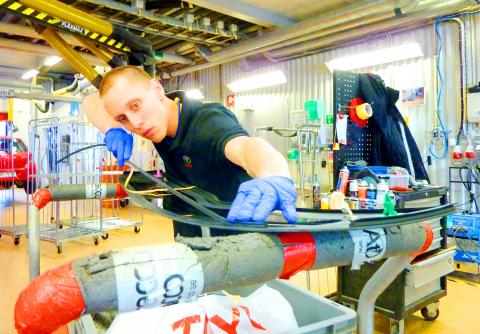Robert Nilsson, a 25-year-old mechanic in Sweden’s second-largest city, Gothenburg, may be the harbinger of a future where people work less and still enjoy a high standard of living.
He gets out of bed at the same time as everyone else, but instead of rushing to work, he takes it easy, goes for a jog, enjoys his breakfast, and doesn’t arrive at his Toyota workshop until noon, only to punch out again at 6pm.
“My friends hate me. Most of them think because I work six hours, I shouldn’t be paid for eight,” Nilsson said, talking while fitting part of a rear window onto a Toyota Prius with swift, expert moves.

Photo: AFP
Sweden often stuns first-time visitors with its laid-back prosperity, making foreigners wonder how it is possible to have both lots of money and lots of leisure.
Part of the answer, according to economists, is a productive and well-educated workforce that adapts to new technologies quicker than most.
Exactly how much — or how little — Swedes work compared with other nations is a somewhat open question.
“We have a 40-hour work week, but also we have a little more absence than many people and we start work late in life because we study longer,” said Malin Sahlen, an analyst at Timbro, a libertarian Stockholm-based think tank.
In 2012, the average Swede worked a total of 1,621 hours, according to the Paris-based Organization for Economic Co-operation and Development.
This is more than the Netherlands with 1,381 hours, but less than Britain with 1,654 hours or the US with 1,790 hours — and way below Chile’s 2,029 and Mexico’s 2,226 hours.
“We could work more, that’s a fact,” said Sahlen.
LEISURE TIME
But far from looking to increase time spent at work, some in Sweden are out to prove that less is more and that cutting hours can boost productivity.
In an international productivity ranking by the Conference Board, a non-profit business research organization, Sweden was already placed close to the top, coming 11th out of 61 countries.
The US was third, the Netherlands number five, and Britain number 13, whereas Chile and Mexico were both in the bottom third.
Now, the Social Democrat-led city government in Gothenburg is planning to test the impact of shorter hours on productivity, in an experiment beginning on July 1.
One group of government workers in the elderly care sector are to work six hours a day, while another will work the eight they are used to.
After a year, the municipal government will analyze the results and decide whether the six-hour day brings enough savings — in the form of fewer sick days for instance — that it warrants becoming permanent and extended to other sectors.
So far, the plan is limited to the civil service, but city councilor Mats Pilhem of the Left Party is convinced that all of Sweden is headed towards a shorter work day.
“People have long work lives, and it’s necessary to think of ways to create a more humane environment for them in the workplace,” he said.
‘CRAZY IDEA’
Critics like Timbro’s Sahlen warn the math does not add up in terms of the wider economy, saying it would be far too expensive to make a large part of the labor force work 25 percent less — for the same pay.
“I think it’s a crazy idea and I don’t think it’s going to be reality either,” she said.
Opponents say shorter workweeks have been experimented across Europe — 35 hours in France and Germany, an average of 30 hours in the Netherlands — to mixed economic results.
“It’s the kind of populist and socialist policy that’s very dangerous for the economy, and we shouldn’t go through with it,” warned Maria Ryden, a member of Gothenburg city council for the center-right Moderates, which oppose the plans.
“We’re capable of working more.”
But proponents of cutting the workday point at short term benefits in the form of fewer sick days, and greater efficiency at work due to fewer breaks.
And they argue greater savings will come in the long run, with a workforce that is less exhausted and therefore more productive as it approaches retirement.
SIX-HOUR WORKDAY
Left-wing councilor Pilhem says the concept has already proven its merits — at mechanic Nilsson’s workplace, Toyota.
Toyota’s Gothenburg branch introduced the six-hour day in 2002 to make its facilities more efficient by having two shifts, one in the morning and one in the afternoon, instead of a single, longer one.
Nilsson confirms that in his experience a six-hour day — paid as much as eight — is more efficient because it requires fewer breaks.
“Every time you have a break, it takes 10 to 15 minutes to get back to work, because you have to see where you were when you left off,” he said.
That efficiency is reflected in the salary, as the Toyota workshop pays technicians like Nilsson 29,700 Swedish kronor (US$4,510) a month, well above the 25,100 kronor (US$3,810) national average for workers in the private sector.
“It was a huge success straight away,” said Toyota service center manager Elisabeth Jonsson.
“We saw the results, and everything was working for the staff, for the company, for the customers, so I don’t think we ever had any discussion about putting an end to it.”

The unexpected collapse of the recall campaigns is being viewed through many lenses, most of them skewed and self-absorbed. The international media unsurprisingly focuses on what they perceive as the message that Taiwanese voters were sending in the failure of the mass recall, especially to China, the US and to friendly Western nations. This made some sense prior to early last month. One of the main arguments used by recall campaigners for recalling Chinese Nationalist Party (KMT) lawmakers was that they were too pro-China, and by extension not to be trusted with defending the nation. Also by extension, that argument could be

Aug. 4 to Aug. 10 When Coca-Cola finally pushed its way into Taiwan’s market in 1968, it allegedly vowed to wipe out its major domestic rival Hey Song within five years. But Hey Song, which began as a manual operation in a family cow shed in 1925, had proven its resilience, surviving numerous setbacks — including the loss of autonomy and nearly all its assets due to the Japanese colonial government’s wartime economic policy. By the 1960s, Hey Song had risen to the top of Taiwan’s beverage industry. This success was driven not only by president Chang Wen-chi’s

Last week, on the heels of the recall election that turned out so badly for Taiwan, came the news that US President Donald Trump had blocked the transit of President William Lai (賴清德) through the US on his way to Latin America. A few days later the international media reported that in June a scheduled visit by Minister of National Defense Wellington Koo (顧立雄) for high level meetings was canceled by the US after China’s President Xi Jinping (習近平) asked Trump to curb US engagement with Taiwan during a June phone call. The cancellation of Lai’s transit was a gaudy

The centuries-old fiery Chinese spirit baijiu (白酒), long associated with business dinners, is being reshaped to appeal to younger generations as its makers adapt to changing times. Mostly distilled from sorghum, the clear but pungent liquor contains as much as 60 percent alcohol. It’s the usual choice for toasts of gan bei (乾杯), the Chinese expression for bottoms up, and raucous drinking games. “If you like to drink spirits and you’ve never had baijiu, it’s kind of like eating noodles but you’ve never had spaghetti,” said Jim Boyce, a Canadian writer and wine expert who founded World Baijiu Day a decade